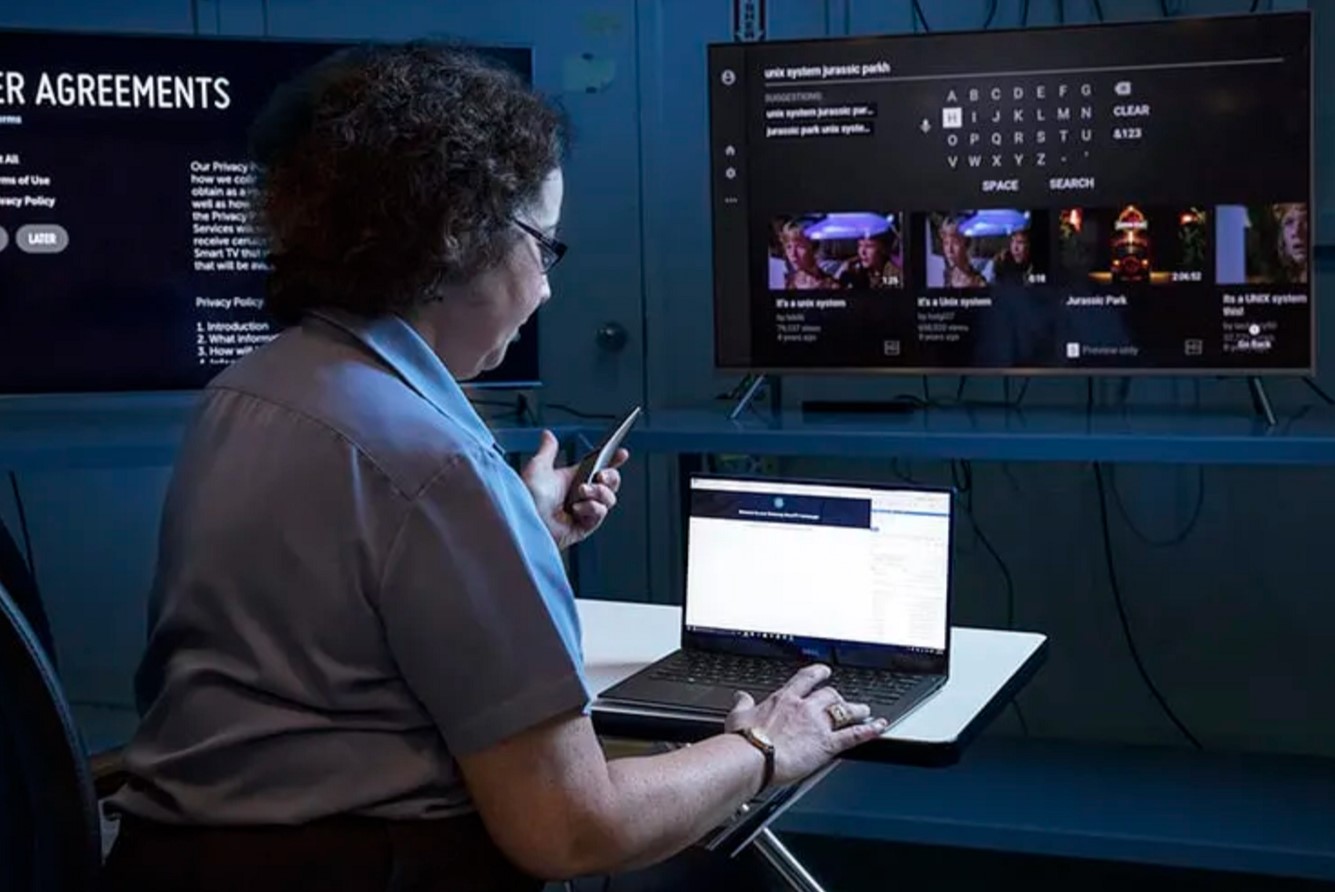Home>Technology>Home Entertainment Systems>How Does A Television Work


Home Entertainment Systems
How Does A Television Work
Modified: January 9, 2024
Discover the inner workings of a television and learn how it brings entertainment into your home. Explore the fascinating world of home entertainment systems.
(Many of the links in this article redirect to a specific reviewed product. Your purchase of these products through affiliate links helps to generate commission for Storables.com, at no extra cost. Learn more)
Introduction
Welcome to the fascinating world of home entertainment systems! In today’s fast-paced and tech-driven society, having a high-quality television is essential for enjoying movies, sports events, TV shows, and gaming experiences right in the comfort of our homes. But have you ever wondered how a television actually works? In this article, we’ll take a deep dive into the technology behind televisions, explore how they function, and understand the various types of televisions available in the market today.
Television technology has come a long way since its inception, evolving from bulky, black-and-white boxes to sleek, high-definition screens that offer immersive viewing experiences. The development of televisions has been driven by advancements in electrical engineering, display technologies, and signal transmission systems. Understanding the inner workings of a television can help us appreciate the incredible feat of engineering that goes into bringing us our favorite TV shows, movies, and games.
In the following sections, we’ll explore the mechanics of televisions, including the different types of display technologies such as Cathode Ray Tube (CRT), Liquid Crystal Display (LCD), Light Emitting Diode (LED), and Plasma Display Panel (PDP). We’ll also delve into the intricacies of television signals, broadcasting and reception, and the evolution of color television. Additionally, we’ll touch upon sound systems in televisions, remote controls, and the various features and functions available in modern televisions.
Whether you’re a tech enthusiast looking to expand your knowledge or a home entertainment system shopper wanting to make an informed decision, this article aims to provide a comprehensive understanding of television technology. So, let’s dive in and unravel the mysteries behind the mesmerizing world of televisions!
Key Takeaways:
- Television technology has evolved from bulky CRTs to sleek LED displays, offering vibrant visuals and immersive audio. With smart features and advanced functions, modern TVs provide endless entertainment possibilities.
- From color reproduction to advanced audio, televisions have transformed into immersive home entertainment hubs. With smart capabilities, high refresh rates, and HDR, TVs offer captivating experiences for all viewers.
Read more: How Does A Mechanical Television Work
Overview of Television Technology
Television technology has evolved significantly over the years, revolutionizing how we consume visual media. From the early days of black-and-white CRT televisions to the vibrant and sleek flat-screen displays we have today, let’s explore the different types of television technologies that have shaped the home entertainment industry.
Cathode Ray Tube (CRT): The CRT was the standard television technology for several decades. It works by firing electrons from a cathode ray tube onto a phosphor-coated screen, creating images by manipulating the intensity of the electron beams. CRTs offered decent picture quality but were bulky and consumed more power compared to newer technologies.
Liquid Crystal Display (LCD): LCD televisions gained popularity in the early 2000s. LCD panels consist of a layer of liquid crystals sandwiched between two polarizing filters. By applying electrical current to specific pixels, the liquid crystals control the amount of light passing through, creating images. LCD displays offered improved energy efficiency and slimmer form factors compared to CRTs.
Light Emitting Diode (LED): LED televisions are an advancement of LCD technology, replacing the traditional cold cathode fluorescent lamps (CCFLs) with light-emitting diodes (LEDs) as the backlight source. This results in improved contrast, better color reproduction, and greater energy efficiency. LED TVs quickly became the standard and laid the foundation for the transition to flat-screen displays.
Plasma Display Panel (PDP): Plasma televisions were popular in the early 2000s. They utilized millions of tiny cells containing noble gases that, when electrically charged, emitted ultraviolet light. This UV light then interacted with phosphors to create the visible image. Plasma TVs offered excellent contrast ratios and wider viewing angles, making them ideal for home theater setups.
Organic Light Emitting Diode (OLED): OLED technology represents the latest innovation in television displays. OLED panels consist of organic compounds that emit light when an electric current is applied. Unlike LCD and LED TVs, OLED TVs don’t require a separate backlight, resulting in perfect blacks, infinite contrast ratios, and vibrant colors. OLED displays are known for their slim profiles and excellent viewing angles.
These different types of television technologies have their own strengths and weaknesses, and manufacturers continue to push boundaries in terms of picture quality, color accuracy, and energy efficiency. As a result, consumers now have a wide range of options to choose from when it comes to selecting a television that suits their needs and preferences.
In the next sections, we’ll explore the inner mechanisms of these television technologies to gain a deeper understanding of how they deliver the stunning visuals that enhance our home entertainment experiences.
Television Mechanics
Television mechanics refer to the inner workings and components that allow a television to function and display images and sounds. Understanding these mechanics can help us appreciate the complexity behind creating the visual feast we enjoy on our screens.
The core component of a television is the display panel, which houses the technology responsible for creating the images we see. Different television technologies use various mechanisms to generate these images:
- Cathode Ray Tube (CRT): In CRT televisions, a cathode ray tube is used to produce the images. This tube emits a stream of electrons, which are focused and guided by electromagnets to strike the phosphor-coated screen. The impact of the electrons causes the phosphors to emit light, creating the visual display.
- Liquid Crystal Display (LCD): LCD televisions work by using liquid crystal molecules that can be twisted or untwisted to either block or permit the passage of light. An array of tiny pixels contains liquid crystals layer sandwiched between two polarizing filters. By applying electrical currents to the liquid crystals, the pixels can control the intensity and color of the light passing through them, forming the images we perceive.
- Light Emitting Diode (LED): LED TVs are based on LCD technology, but instead of using cold cathode fluorescent lamps (CCFLs) as the backlight source, they employ arrays of light-emitting diodes (LEDs). These LEDs provide the necessary illumination that passes through the liquid crystal pixels to create the image.
- Plasma Display Panel (PDP): Plasma televisions utilize tiny cells filled with a mixture of noble gases, such as xenon and neon. These cells are sandwiched between two glass plates. When an electrical current runs through the cells, the gases ionize, emitting ultraviolet light. This light then causes phosphors to emit visible light, forming the images on the screen.
- Organic Light Emitting Diode (OLED): OLED displays consist of organic compounds that emit light when an electric current is applied. Each pixel in an OLED TV is composed of tiny organic diodes that emit colored light independently. This feature allows for precise control over individual pixel brightness and color, resulting in exceptional contrast, vibrant colors, and true black levels.
Regardless of the display technology used, televisions also require other essential components to function:
- Signal processors: These processors receive and decode the incoming signals, such as broadcast signals or signals from connected devices, and convert them into the appropriate format for display on the television screen.
- Tuners: Tuners are responsible for receiving television signals, whether they are from antenna, cable, satellite, or internet sources. They tune into specific channels and extract the audio and video content, which is then processed and displayed on the screen.
- Audio systems: Televisions also incorporate audio systems, which can vary in complexity and capabilities. From stereo speakers to advanced surround sound systems, the audio components deliver the accompanying sounds that complete the home entertainment experience.
- Interfaces and ports: Modern televisions include a variety of interfaces and ports for connecting external devices such as gaming consoles, Blu-ray players, streaming devices, and audio systems. These interfaces enable seamless integration and provide options for expanding the entertainment possibilities.
- Power supply: All televisions require a power source to function. This power supply converts the incoming electrical power to the necessary voltage and current required to operate the television’s components.
These components work together harmoniously to create the vibrant and captivating images and sounds that bring our favorite movies, TV shows, and games to life. Understanding the mechanics behind televisions allows us to appreciate the technology and innovation that goes into producing these remarkable devices.
Cathode Ray Tube (CRT)
Before the advent of modern flat-panel displays, Cathode Ray Tube (CRT) televisions dominated the market for several decades. The CRT technology played a significant role in shaping the television industry and was the standard display technology for most households.
A cathode ray tube is a large, vacuum-sealed glass tube that consists of several key components:
- Cathode: The cathode is a heated filament located at one end of the CRT. It emits electrons when heated, creating a negatively charged electron cloud.
- Electron Gun: The electron gun is positioned near the cathode and consists of an electron source, focusing anodes, and an acceleration anode. It releases and accelerates the electrons towards the front of the tube.
- Deflection System: The deflection system consists of magnetic coils or plates that deflect the electron beam as it moves across the screen. By manipulating the magnetic fields, the electron beam’s path can be controlled, allowing for the creation of images.
- Phosphor-Coated Screen: The front inner surface of the CRT is coated with phosphors, which emit light when struck by high-speed electrons. The phosphors are arranged in tiny dots known as pixels, and the combination of different phosphor colors (typically red, green, and blue) creates a full-color display.
- Shadow Mask or Aperture Grille: In color CRT televisions, a shadow mask or aperture grille is used to ensure that the electron beams accurately hit the correct phosphor dots on the screen. These components help to separate the three primary colors, ensuring precise color reproduction.
When a CRT television is turned on, the cathode heats up, emitting a stream of electrons. The electron gun accelerates these electrons towards the front of the tube, creating a beam that moves across the screen in a scanning pattern. The deflection system controls the movement of the electron beam, allowing it to traverse horizontally and vertically across the screen at a rapid rate.
As the electron beam strikes the phosphor-coated screen, it causes the phosphors to emit light, creating pixels of different colors and intensities. By selectively controlling the intensity of the electron beam and scanning it over the entire screen, different images can be formed. The combination of millions of pixels working together creates the detailed pictures we see on the CRT screen.
While CRT technology offered decent picture quality and color reproduction, it did have some drawbacks. CRT televisions were quite bulky and heavy due to the size of the cathode ray tube. Additionally, they consumed more power compared to newer display technologies and had limited screen sizes available.
Despite being largely phased out by newer display technologies like LCD and LED, CRT televisions played a crucial role in our history of home entertainment systems. They paved the way for the development of flat-panel displays and served as the foundation for the televisions we enjoy today.
Liquid Crystal Display (LCD)
Liquid Crystal Display (LCD) technology revolutionized the television industry in the early 2000s and quickly became the go-to display technology for consumer electronics. LCD screens are known for their slim profiles, energy efficiency, and vibrant colors.
The key component of an LCD television is the liquid crystal panel. The panel consists of a layer of liquid crystals sandwiched between two polarizing filters. Here’s how the LCD technology works:
- Polarization: The first polarizing filter allows only horizontally polarized light to pass through. This polarized light then enters the liquid crystal layer.
- Twisting Liquid Crystals: The liquid crystal molecules in the panel can be twisted or untwisted when an electric current is applied. In their natural state, the liquid crystals are twisted, and the polarized light rotates as it passes through.
- Controlled Light Intensity: The electric current applied to specific pixels controls the orientation of the liquid crystals in those pixels. When an electric current is applied, the liquid crystals untwist, allowing the light to pass through, resulting in high brightness. Conversely, when no electric current is applied, the liquid crystals remain twisted, blocking the light and creating dark pixels.
- Color Filters: Color filters, typically red, green, and blue, are placed over each pixel on the liquid crystal panel. These filters allow only specific colors of light to pass through, based on the image being displayed. By combining these primary colors, a full-color display is formed.
- Backlight: LCD televisions use a separate backlight source positioned behind the liquid crystal panel. This backlight provides the necessary illumination for the liquid crystals to create an image. In earlier LCD TVs, cold cathode fluorescent lamps (CCFLs) were used as the backlight source. However, modern LCD TVs use light-emitting diodes (LEDs) which offer improved energy efficiency and better control over brightness levels.
When the backlight is turned on, it shines through the liquid crystal panel. The liquid crystals in each pixel can be individually controlled to either allow the light to pass through or block it, depending on the desired image. By manipulating the orientation of the liquid crystals at the pixel level, different colors and shades are created, resulting in a full-color image on the screen.
LCD technology offers several advantages, including slim design, energy efficiency, and excellent color reproduction. However, there are some limitations to be aware of. LCD panels have a limited viewing angle, meaning that the image quality may degrade when viewed from extreme angles. Additionally, LCD displays may suffer from motion blur, where fast-moving objects may appear blurry or leave a trail behind them.
To address these limitations, manufacturers have introduced advancements like in-plane switching (IPS) and twisted nematic (TN) panels. These technologies improve viewing angles, color accuracy, and response times, enhancing the overall viewing experience.
Despite newer technologies like OLED gaining popularity, LCD televisions continue to be widely used due to their affordability, wide availability, and reliable performance. LCD technology enabled the transition to flat-screen displays and played a pivotal role in transforming how we watch and enjoy television.
Read more: 3D Television: How Does It Work?
Light Emitting Diode (LED)
The Light Emitting Diode (LED) technology has revolutionized the television industry, offering significant advancements in picture quality, energy efficiency, and design. LED televisions have become the standard choice for consumers, delivering stunning visuals and an immersive viewing experience.
LED technology builds upon the foundation of Liquid Crystal Display (LCD) technology and replaces the traditional cold cathode fluorescent lamps (CCFLs) used in LCD TVs as the backlight source with arrays of light-emitting diodes. Here’s how LED TVs work:
- LED Backlighting: LED televisions feature an array of thousands of tiny light-emitting diodes positioned behind the liquid crystal panel. These diodes serve as the backlight source for the display.
- Local Dimming: LED TVs often incorporate a feature called local dimming, where the backlighting is segmented into zones. This allows for more precise control over the brightness levels in specific areas of the screen. By dimming or turning off the LEDs in darker areas, LED TVs can achieve deeper blacks and improved contrast ratios.
- Color Enhancement: LED televisions utilize various techniques to enhance color reproduction. These include using quantum dots, which are tiny semiconductor crystals that emit light of specific colors when illuminated by the LED backlight. Quantum dot technology allows for a wider color gamut and more accurate color representation.
- Edge-Lit vs. Direct-Lit: LED TVs can be categorized as either edge-lit or direct-lit. Edge-lit models have LEDs positioned along the edges of the screen, directing light towards the center. Direct-lit TVs have LEDs placed uniformly behind the entire screen. Direct-lit TVs generally offer better control over local dimming and can provide more uniform backlighting.
The integration of LED technology brings numerous advantages to television displays:
- Improved Energy Efficiency: LED TVs consume significantly less power compared to older technologies like CRT and even conventional LCD TVs with CCFL backlights. LEDs are more energy-efficient as they emit light directly, whereas CCFL lamps require additional power to produce light.
- Enhanced Contrast Ratio: LED backlighting allows for better control over the brightness levels of individual zones, resulting in a more dynamic and impressive contrast ratio. This means deeper blacks and brighter whites, enhancing the overall image quality and clarity.
- Slimmer Design: LED TVs are known for their slim profiles due to the compact size of the LED backlighting. This slim design not only enhances the aesthetics of the television but also makes it easier to mount on walls or fit into tight spaces.
- High Definition and 4K Resolution: LED technology seamlessly supports high-definition and 4K resolution, delivering exceptionally sharp and detailed images. The precise control over backlighting allows LED TVs to showcase the incredible detail of these higher resolution formats.
- Longer Lifespan: LED TVs typically have a longer lifespan compared to other display technologies. LED diodes have a longer operational life, reducing the need for frequent replacement and maintenance.
LED technology has become the industry standard for television displays, offering an impressive combination of picture quality, energy efficiency, and sleek design. Whether you’re enjoying your favorite movies, TV shows, or gaming sessions, LED televisions provide a visually captivating experience that immerses you in the content like never before.
Plasma Display Panel (PDP)
The Plasma Display Panel (PDP) was a popular television technology in the early 2000s, offering impressive image quality and vibrant colors. While it has largely been phased out by newer display technologies, understanding the workings of a PDP can provide insight into the development of televisions over the years.
A Plasma Display Panel consists of thousands of tiny cells that contain a mixture of noble gases, such as xenon and neon. Here’s how PDP technology works:
- Gaseous Mixtures: Each cell in the PDP contains a mixture of noble gases sealed between two glass plates. These gases are electrically charged to form plasma – an ionized gas consisting of positively charged ions and negatively charged electrons.
- Ultraviolet Emission: When an electrical current is applied to the cells, the plasma emits ultraviolet (UV) light.
- Phosphor Coating: The front glass plate of the PDP is coated with a layer of different phosphors. These phosphors emit visible light when struck by the UV light from the plasma.
- Color Creation: Each pixel on the screen is composed of three sub-pixels, coated with red, green, or blue phosphors. By varying the intensity of the electrical current applied to each pixel, the plasma generates the appropriate UV light to excite the respective phosphors, creating the desired colors.
As the electrical current passes through the cells, the plasma emits UV light, exciting the phosphors and causing them to emit visible light. By selectively controlling the electric currents across the pixels, hundreds of thousands of colors and shades can be produced, forming the vibrant images on the screen.
PDPs had several advantages over other display technologies:
- Excellent Contrast Ratio: Plasma displays offered deep blacks and impressive contrast ratios, as each pixel emitted its light independently. This resulted in detailed images with sharp contrasts between bright and dark areas.
- Wide Viewing Angles: PDPs featured wide viewing angles, allowing for an optimal viewing experience from various positions in the room. The color and image quality remained consistent, even when viewed from extreme angles.
- Fast Response Time: Plasma displays had rapid response times, making them suitable for fast-paced action scenes and sports events. The quick reaction of the pixels ensured smooth and fluid motion without motion blur.
However, PDP technology also had some drawbacks. Plasma displays were generally heavier and bulkier than their LCD counterparts, making them less suitable for wall mounting or in rooms with limited space. Additionally, PDPs consumed more power compared to newer display technologies, which led to higher electricity costs.
With advancements in LED and OLED technologies offering similar image quality with better energy efficiency and thinner profiles, plasma displays have become less common in the market. Nevertheless, PDPs played a significant role in the evolution of television technology and showcased the possibilities of achieving stunning visuals through the use of plasma and phosphors.
When a television is turned on, an electrical current flows through the TV’s circuitry, powering the display and producing images and sound. The images are created by tiny pixels on the screen that light up in different colors to form the picture.
Television Signals
Television signals are the lifeblood of the broadcast industry, allowing us to receive and enjoy a wide range of programming on our televisions. Understanding television signals is essential in comprehending how information is transmitted from broadcasters to our screens.
Television signals consist of both audio and video components:
- Video Signal: The video signal carries the visual information that forms the images displayed on the television screen. It encodes the picture’s brightness, color, and resolution, allowing us to see the moving images in real-time. Different video signal formats have been used throughout television history, with the most common ones being Standard Definition (SD), High Definition (HD), and Ultra High Definition (UHD or 4K).
- Audio Signal: The audio signal carries the sound information accompanying the video. It encodes spoken dialogue, music, sound effects, and any other audio elements that contribute to the overall viewing experience. Audio signals can be in various formats, including mono (single-channel) or stereo (two-channel), while more advanced systems offer surround sound and immersive audio technologies for a richer audio experience.
Television signals are transmitted using several methods:
- Broadcast Over-the-Air: Over-the-air broadcasting involves transmitting television signals through radio waves from a broadcast tower. This means that viewers with the appropriate antenna can receive the signals without requiring external cable or satellite subscriptions. Over-the-air signals are typically provided by public broadcasters and networks.
- Satellite: Television signals can also be sent directly to satellites in orbit and then broadcast back to Earth for reception. Satellite television provides a wide range of channels and international programming, requiring a direct satellite dish and receiver to capture and decode the signals.
- Cable and IPTV: Cable television systems use physical coaxial or fiber optic cables to transmit signals to subscribers’ homes. These cables carry both television and internet data, allowing for a wide selection of channels and services. Internet Protocol Television (IPTV) delivers television signals over an internet connection, providing access to a multitude of channels and on-demand content.
- Streaming Services: With the rise of high-speed internet connectivity, streaming services have become popular, allowing viewers to access television content over the internet on various devices. Streaming platforms transmit television signals using internet protocols, offering on-demand and live streaming options through subscriptions or ad-supported models.
It’s important to note that television signals can undergo compression to allow for efficient transmission and storage. Compression techniques such as MPEG (Moving Picture Experts Group) encoding reduce the size of audio and video signals without significant loss in quality. This compression enables broadcasters and streaming platforms to transmit a large amount of content over limited bandwidths and storage capacities.
Receiving television signals requires a compatible device, such as a television set, digital set-top box, or streaming device. These devices decode the signals and convert them into audio and video for display on the screen. Additionally, modern televisions often offer built-in tuners and smart capabilities, allowing users to access broadcast channels, cable/satellite services, and streaming platforms directly without external devices.
As technology continues to advance, television signal transmission methods will undoubtedly evolve. From the traditional over-the-air broadcasts to the rise of streaming services, television signals will continue to play a crucial role in delivering engaging and immersive content to our screens.
Broadcasting and Reception
Broadcasting and reception are the fundamental processes that enable television signals to be transmitted from broadcasters to viewers’ homes. These processes involve the distribution of signals, the capturing of those signals, and ultimately, the display of television content on our screens.
Broadcasting: Broadcasting refers to the transmission of television signals from a central location, such as a television studio or broadcasting station, to a wide audience. Broadcasters use specialized equipment to capture and encode audio and video signals, which are then sent through various transmission methods to reach viewers. These methods include:
- Over-the-Air Broadcasting: Over-the-air broadcasting involves transmitting television signals via radio waves from a broadcast tower to antennas in viewers’ homes. Broadcasting towers are strategically placed to cover a specific geographical area, ensuring signal availability to nearby households equipped with antennas capable of receiving those signals.
- Satellite Broadcasting: Satellite broadcasting involves transmitting television signals to satellites in orbit, which then beam the signals back to Earth for reception. Broadcasters uplink their signals to satellites, which have a wide coverage area, enabling transmission to viewers equipped with satellite dishes and receivers.
- Cable and IPTV Broadcasting: Cable television operators and IPTV providers distribute television signals through physical cables or internet connections. These signals are sent directly to subscribers’ homes, enabling access to a wide range of channels and services.
- Streaming Broadcasting: With the advent of high-speed internet connectivity, broadcasters now have the option to transmit television signals through streaming platforms. These platforms distribute television content over the internet, allowing viewers to access programming on various devices connected to the internet.
Reception: Reception refers to the process of capturing television signals and converting them into audio and video for display on television screens. In order to receive television signals, viewers need compatible devices such as television sets, set-top boxes, satellite dishes, or streaming devices. Here’s a general overview of the reception process:
- Antennas: For over-the-air reception, viewers require an antenna to capture radio waves carrying television signals. Antennas can be rooftop-mounted or indoor. They receive the signals and send them to the television or a digital set-top box for decoding.
- Set-Top Boxes: Set-top boxes are devices that decode and process television signals for display on older televisions or those without built-in tuners. They convert the received signals into audio and video formats compatible with the television’s capabilities.
- Satellite Dishes and Receivers: Satellite television reception involves installing a satellite dish aimed at the designated satellite, which captures the broadcasted signals. Viewers require compatible satellite receivers to decode and convert the signals into audio and video for display on their television screens.
- Cable and IPTV Boxes: Cable television and IPTV providers typically provide subscribers with set-top boxes that not only decode signals but also offer additional features. These boxes facilitate channel selection, access to on-demand content, interactive program guides, and interactive services.
- Smart TVs and Streaming Devices: Many modern televisions now have built-in tuners, allowing viewers to directly access over-the-air broadcasts or cable/satellite signals without the need for external devices. In addition, smart TVs and streaming devices connect to the internet, enabling direct access to streaming platforms and online content.
As technology has advanced, the process of broadcasting and reception has become more versatile, offering viewers a wide range of options to access television content. Whether through traditional over-the-air broadcasts, satellite reception, cable and IPTV services, or streaming platforms, television broadcasting and reception are continually evolving to meet the demands of modern viewers.
Read more: How To Work In Television Production
Color Television
Color television revolutionized the way we experience visual content, bringing vibrant and lifelike images into our homes. Prior to the introduction of color television, early televisions could only display black and white images. The development of color television technology allowed for the reproduction of full-color content, enhancing the viewing experience and adding a new dimension to television programming.
The transition from black and white to color television required advancements in both broadcasting and display technologies:
- Broadcasting: To support color television, broadcasters needed a new encoding method for transmitting color information. This led to the development of color television standards, such as the NTSC (National Television System Committee) system in North America, PAL (Phase Alternating Line) in Europe, and SECAM (Sequential Color with Memory) in France and other regions. These systems allowed for the transmission and reception of color signals, ensuring compatibility between broadcasting equipment and television sets.
- Display Technology: Color television required new display technologies capable of reproducing and presenting full-color images. Three primary colors—red, green, and blue—form the basis of color reproduction in televisions. The development of color cathode ray tubes (CRTs), which incorporated phosphors emitting these primary colors, enabled the creation of color television sets.
The process of creating color images on a television screen involves a combination of color signals and phosphor-based display technologies:
- Color Signals: Color signals encode the intensity levels of red, green, and blue that make up a particular color. These signals are either transmitted or stored for later playback. In the NTSC system, color information is encoded as a phase and amplitude modulation signal known as composite video.
- Phosphors and Electron Guns: Color television sets used CRTs that had separate electron guns for red, green, and blue. The electron beams would strike phosphors of the corresponding colors on the screen, causing them to emit light. The combination of these phosphors at different intensities created the full-color image.
- Color Mixing and Display: When the electron beams from the three electron guns hit the phosphor-coated screen, they combined to produce a range of colors. These colors would blend together when viewed from a distance, creating a seamless and vivid display of images.
Color television technology enabled broadcasters to transmit and viewers to experience a wide array of colorful programming, including live events, movies, and television shows. The introduction of color added depth, realism, and immersiveness to the viewing experience, making television content more engaging and captivating.
Over time, advancements in display technologies have replaced CRT-based color televisions with more compact and energy-efficient options, such as LCD, LED, and OLED. These modern display technologies are capable of reproducing even more vibrant and precise colors, elevating the visual quality and accuracy of color reproduction.
Today, color television is the standard, and viewers can enjoy a vast array of content in stunning colors and high-definition resolutions. The evolution of color television has transformed how we perceive and engage with television programming, enhancing our entertainment experiences in countless ways.
Sound in Televisions
Alongside the advancements in visual display technologies, sound in televisions has played a crucial role in enhancing the overall home entertainment experience. The evolution of sound systems in televisions has undergone significant improvements, enabling viewers to enjoy immersive and high-quality audio alongside stunning visual imagery.
Early television sets had limited sound capabilities, often consisting of small built-in speakers that produced basic mono sound. However, with technological advancements, sound in televisions has come a long way, offering more advanced audio technologies and features:
- Basic Stereo Sound: The introduction of stereo sound in televisions brought a significant improvement over mono sound. Stereo sound uses two separate audio channels, typically left and right, to create a sense of spatial audio. This offers a more immersive listening experience, as sounds can be heard from distinct directions.
- Dolby Surround and Surround Sound: Surround sound systems in televisions introduced multi-channel audio, enabling sound to come from different directions, creating a more realistic and enveloping experience. Technologies like Dolby Surround and Dolby Digital enhance the depth and spatiality of audio, providing a captivating and movie-theater-like ambiance.
- Virtual Surround Sound: Virtual surround sound technologies attempt to mimic the effect of a multi-channel audio system using only a few speakers. Through advanced audio processing algorithms, virtual surround sound creates an illusion of sound coming from multiple directions, heightening the audio experience without the need for additional speakers.
- Soundbar Integration: Soundbars have become popular external audio solutions for televisions. These long, sleek speaker systems can be placed below or above the television, delivering enhanced audio quality and often incorporating advanced audio technologies, such as wireless connectivity, subwoofers for deep bass, and virtual surround sound capabilities.
- Smart Speakers and Voice Control: Some modern televisions integrate smart speaker functionality, allowing users to control their television using voice commands. Smart speakers also offer the convenience of hands-free control for various tasks, including changing channels, adjusting volume, and even accessing streaming services.
- Advanced Audio Codecs: Over time, audio codecs like Dolby Atmos and DTS:X have become increasingly common in televisions. These advanced audio codecs provide object-based audio, allowing sound to be precisely placed in three-dimensional space, creating a more immersive and realistic sound experience.
With these advancements, television viewers can now enjoy higher fidelity sound, rich bass, clearer dialogues, and a more immersive audio experience that complements the stunning visuals on screen. The integration of advanced audio technologies in televisions has brought the theater-like experience into our living rooms, providing a more captivating and engaging entertainment experience.
It’s important to note that while televisions have improved sound quality, dedicated audio systems or soundbars can provide an even more powerful and immersive audio experience. These external sound solutions offer a wider soundstage, better frequency response, and more robust audio capabilities, making them ideal for those seeking an elevated home theater experience.
As technology continues to advance, we can expect further innovations in television sound systems, with a focus on object-based audio, spatial audio technologies, and seamless integration with other smart home devices. The evolution of sound in televisions ensures that the audio aspect of our home entertainment experience can be just as captivating and immersive as the visuals displayed on our screens.
Remote Controls
Remote controls have become an essential companion to our televisions, offering convenience and the ability to easily navigate through channels, adjust settings, and control various features without having to physically interact with the television itself. Remote controls have evolved significantly over the years, providing users with intuitive and user-friendly interfaces to enhance their overall viewing experience.
Here are some key aspects and features of remote controls:
- Wireless Control: Remote controls use wireless technology to communicate with the television. Infrared (IR) technology was commonly used in older remote controls, while modern ones often utilize radio frequency (RF) or Bluetooth technology for improved reliability and longer range.
- Number and Arrangement of Buttons: Remote controls feature an array of buttons to control various functions. These buttons can include power, volume, channel selection, menu navigation, and specific buttons for accessing streaming services, input selection, or other features. The arrangement and number of buttons can vary between different remote control models and manufacturers.
- Multifunctionality: Many remote controls offer multifunctionality, allowing users to control not only the television but also connected devices such as set-top boxes, gaming consoles, audio systems, and streaming devices. This reduces the need for separate remote controls for each device, streamlining the user experience.
- Smart Features: Remote controls for smart TVs often incorporate dedicated buttons for accessing smart features and applications. These buttons may include shortcuts to popular streaming platforms, voice search activation, or even dedicated buttons for specific smart features like screen mirroring or home automation integration.
- Backlit and Touch-Sensitive Controls: Some remote controls offer backlit buttons or touch-sensitive surfaces, making it easier to navigate and control the television in low-light or dark environments. Backlighting ensures that the buttons are visible, while touch-sensitive controls provide a sleek and interactive user experience.
- Voice Control: With the integration of voice recognition technology, some remote controls feature built-in microphones for voice control functionality. Users can issue voice commands to control their television, change channels, adjust volume, search for content, or access other smart features without having to press buttons manually.
- Universal Remote Controls: Universal remote controls are designed to consolidate the control of multiple devices into a single remote. These advanced remotes can be programmed to control various brands and models of televisions, set-top boxes, Blu-ray players, and other devices, reducing clutter and simplifying the user experience.
Remote controls have become an integral part of the television viewing experience, providing convenience and ease of use. They give us the ability to control our televisions from a comfortable distance, allowing seamless navigation, content selection, and personalized settings.
As technology continues to advance, remote controls are likely to incorporate more features and offer more seamless integration with smart home devices. With smart assistants like voice-enabled speakers becoming more prevalent, we can expect further integration of voice control capabilities, enabling users to interact with their televisions and connected devices using natural language commands.
Remote controls are constantly evolving to meet the changing needs of consumers, providing a simple yet powerful tool to enhance our television viewing experience. With their intuitive interfaces and convenient functionalities, remote controls have become an essential accessory that helps us effortlessly navigate the vast world of entertainment right from the comfort of our own living rooms.
Television Features and Functions
Modern televisions come equipped with a wide array of features and functions designed to enhance the viewing experience and cater to the diverse needs and preferences of consumers. Let’s explore some of the common features and functions found in televisions today:
- Smart TV Capabilities: Smart TVs offer internet connectivity, allowing users to access a variety of online streaming services, browse the web, and interact with apps. These televisions often come with pre-installed apps and offer the flexibility to download additional apps based on user preferences.
- Screen Mirroring and Casting: Many televisions now support screen mirroring, allowing users to display the content from their smartphones, tablets, or computers directly onto the television screen. This feature enables effortless sharing of photos, videos, and other media with a larger audience.
- High Dynamic Range (HDR): HDR technology enhances the contrast and color accuracy of television displays, resulting in more vibrant and lifelike images. HDR enables a greater dynamic range between the darkest and brightest parts of the image, creating a more immersive and visually stunning viewing experience.
- 120Hz/240Hz Refresh rates: Higher refresh rates provide smoother motion and reduce motion blur, especially for fast-paced action sequences or sports events. The higher the refresh rate, the more fluid the on-screen movement appears.
- Gaming Features: Some televisions offer specific features tailored for gaming enthusiasts. These features may include low input lag, high refresh rates, game mode settings to enhance image quality and responsiveness, and variable refresh rate technologies like AMD FreeSync or NVIDIA G-SYNC for smoother gameplay.
- Audio Enhancement: Televisions often come equipped with audio enhancement features, such as virtual surround sound, equalizer settings, and various sound modes. These features improve the audio experience and allow users to customize sound settings based on personal preferences and the content being watched.
- USB and HDMI Inputs: Televisions usually include multiple USB ports and HDMI inputs to connect external devices such as gaming consoles, Blu-ray players, streaming devices, and sound systems. These inputs enable seamless integration and easy access to multimedia content.
- Parental Controls: Parental control features allow users to restrict certain content based on their preferences, helping parents ensure that the television content is suitable for their children. These controls may include content ratings, channel blocking, and access restrictions to specific apps or websites.
- Energy-Saving Modes: To promote energy efficiency, televisions often incorporate energy-saving modes that adjust the backlight intensity, optimize power consumption, and automatically turn the screen off when there is no activity detected for a specific period of time.
- Electronic Programming Guide (EPG): Electronic Programming Guides provide an on-screen interface that displays a programming schedule, allowing users to easily navigate and select preferred channels or programs. The EPG may also provide additional information about the content, such as episode details or upcoming shows.
These features and functions are designed to elevate the television viewing experience, offering convenience, customization, and access to a vast range of content. They cater to different preferences, whether it’s streaming the latest shows, enjoying immersive gaming, or personalizing the audio and video settings for optimal enjoyment. With the continuous advancement of technology, televisions are continually evolving to provide even more innovative and user-friendly features, making the home entertainment experience more immersive and enjoyable than ever before.
Read more: How Do Television Ratings Work
Conclusion
The world of home entertainment systems and televisions has witnessed remarkable advancements in technology, transforming the way we experience visual and audio content. From the early days of bulky black-and-white CRT televisions to the sleek and vibrant flat-screen displays we have today, the evolution of television technology has been truly remarkable.
We have explored the mechanics behind different television technologies such as CRT, LCD, LED, and PDP, understanding how they create the captivating images that grace our screens. We have delved into the intricacies of television signals, broadcasting, and reception, uncovering the various methods through which television content is transmitted and received.
Furthermore, we have touched upon the significance of color television, which brought a new dimension to our viewing experience, creating vivid and lifelike images on our screens. The advancements in sound systems have also played a critical role, providing immersive and high-quality audio to complement the visuals.
Remote controls have become indispensable tools, allowing us to effortlessly navigate through channels, adjust settings, and control various features right from the comfort of our seats. And with the integration of smart capabilities, televisions have become more than just screens, providing access to a world of online content, streaming services, and interactive features.
As we look to the future, we can expect televisions to continue evolving, embracing more advanced technologies, and delivering even more captivating experiences. With features like HDR, high refresh rates, smart functionality, and audio enhancements, televisions are poised to provide even more immersive and personalized viewing experiences.
Whether we are enjoying our favorite movies, engaging in intense gaming sessions, or staying up to date with the latest news and shows, televisions have become central to our entertainment lives. The combination of exceptional visual quality, enhanced audio experiences, and an array of features and functions ensures that our home entertainment systems continue to captivate and enthrall us.
By embracing the ever-evolving technology in the world of televisions, we can create our own personal home cinemas, immersing ourselves in a world of endless entertainment possibilities. So, sit back, relax, and enjoy the mesmerizing world of home entertainment right at your fingertips.
Frequently Asked Questions about How Does A Television Work
Was this page helpful?
At Storables.com, we guarantee accurate and reliable information. Our content, validated by Expert Board Contributors, is crafted following stringent Editorial Policies. We're committed to providing you with well-researched, expert-backed insights for all your informational needs.













0 thoughts on “How Does A Television Work”